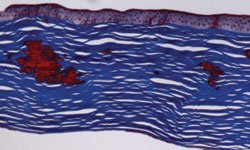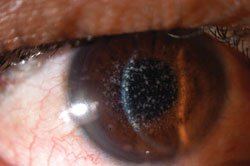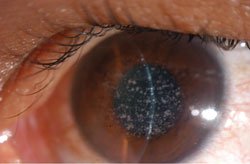Patient presents with increasing photosensitivity and gradually decreasing vision
On examination, central gray-white opacities were seen in the anterior to mid-stroma.
 Catherine A. Cox |
 Jordana F. Goren |
A 37-year-old man from Puerto Rico was referred to the New England Eye Center for an approximate 5-year history of progressive vision loss, photosensitivity and glare. More recently, he noted worsening discomfort upon waking accompanied by severe redness of the right eye worse than the left. He denied any trauma, flashes, floaters, diplopia or headaches.
The patient had no additional medical, ocular or family history. He was a native of Puerto Rico, denied any tobacco or drug use, and drank alcohol socially.The patient’s best corrected visual acuity was 20/50 in the right eye and 20/60 in the left. Pupils, extraocular movements and intraocular pressures were all within normal limits. On slit lamp biomicroscopy, central gray-white opacities were present in the anterior to mid-stroma with clear areas of cornea between adjacent opacities and at the limbus (Figures 1a and 1b). Fundus examination was normal in both eyes.
|
|
|
|
Figures 1a and 1b. Photographs of the right
and left eye. Central gray-white opacities are visible in the anterior to
mid-stroma. Areas of intervening clear cornea are present between opacities as
well as at the limbus.
Images: Sodhi A, Wu HK |
|

What is your diagnosis?
Corneal opacities
The differential diagnosis is limited due to the classic appearance of this patient’s corneal opacities but should include corneal dystrophies such as granular, Avellino, macular, and Reis-Buckler’s.
Granular dystrophy specifically affects the mid-stroma, with opacities separated by clear areas of cornea centrally and at the peripheral limbus. These opacities stain positive with Masson trichrome, indicating the presence of hyaline. Avellino dystrophy presents with both granular and lattice-like deposits consisting of hyaline and amyloid, respectively, in the mid-stroma. As with granular dystrophy, the hyaline deposits stain with Masson trichrome, whereas the amyloid deposits exhibit apple-green birefringence when stained with Congo red. Macular dystrophy has a slightly different appearance with gray-white anterior stromal opacities, but unlike granular dystrophy, stromal haze is present between deposits and the entire cornea is affected from limbus to limbus. Deposits are composed of keratan sulfate, which stains blue with alcian blue. Finally, Reis-Buckler’s dystrophy is a variant of granular dystrophy in which hyaline deposits are located in both the anterior stroma and subepithelium instead of in the anterior to mid-stroma.
Follow-up
The patient underwent penetrating keratoplasty of the right eye. Histology of the patient’s corneal tissue stained positive with Masson trichrome, indicating the presence of hyaline deposits (Figures 2 and 3). There was no evidence of staining with either Congo red or alcian blue stains.
 Figure 2. Pathology section of cornea with eosinophilic hyaline deposits in the anterior to mid-stroma. |
 Figure 3. Pathology section of cornea with positive red staining with Masson trichrome. |
The patient was counseled on the possibility of recurrence in his right eye following penetrating keratoplasty. At a 5-month follow-up visit, his vision improved and symptoms of glare and photosensitivity had resolved.
Discussion
Granular dystrophy typically presents with a gradual decrease in visual acuity accompanied by photosensitivity and glare. Pain is rare due to corneal opacities being located in the anterior to mid-stroma. These opacities appear as discrete, grayish-white, irregular granules with sharp margins, and intervening areas of clear cornea are present between adjacent opacities as well as at the peripheral limbus. These opacities may be apparent in the first decade of life, but vision remains good throughout childhood. As the opacities enlarge and multiply, the cornea becomes increasingly opaque such that older patients experience considerable loss of vision.
Granular dystrophy follows an autosomal dominant inheritance pattern and results from a mutation in the TGF-b gene known as BIGH3 (5q31). The quantity of opacities can vary considerably both within and between families. Cases of sporadic mutations and variable penetrance have also been reported. BIGH3 is responsible for producing keratoepithelin, an adhesion protein secreted by the corneal epithelium. A mutation in BIGH3 leads to the production of a denatured protein, causing deposition of hyaline granules in the corneal stroma.
Treatment options include phototherapeutic keratectomy (PTK) for superficial corneal opacities, as well as lamellar or penetrating keratoplasty for deeper corneal involvement. Recurrences can occur following any of these procedures. Given its relative rarity, there are no studies in the literature looking at rates of recurrence in granular dystrophy alone. In a study published in Ophthalmology, however, the recurrence rate following PTK in patients with Reis-Buckler’s, anterior basement membrane, lattice and granular dystrophies combined was estimated to be as high as 40% (17 out of 43 eyes) within 40 months.
Future treatments aim to take advantage of the high expression of TGF-beta1 in the corneal epithelium, as well as to introduce alternative surgical techniques. In a study published in Archives of Ophthalmology, limbal stem cell transplantation was studied in four eyes of four patients with lattice dystrophy to see if replacement of the host epithelium would lead to a decrease in recurrence following penetrating keratoplasty. These patients underwent penetrating limbo-keratoplasty and were treated with 6 months of systemic cyclosporine followed by long-term therapy with oral steroids. No recurrences were noted in 12 months to 35 months of follow-up. This study was limited by its small number of patients and lack of controls, but nevertheless offers a promising option for patients with vision-altering conditions such as granular dystrophy.
References:
- Birkholz ES, Syed NA, Wagoner MD. Corneal stromal dystrophies: a clinicopathologic review. EyeRounds.org. http://webeye.ophth.uiowa.edu/eyeforum/cases/43-Corneal-Stromal-Dystrophies.htm. Published Aug. 17, 2009. Accessed Oct. 1, 2011.
- Chiambaretta F, Pilon F, Deriot JB, et al. Early recurrence of Groenouw type I corneal dystrophy after phototherapeutic keratectomy. Molecular biology study suggests epithelial genesis. J Fr Ophtalmol. 2004;27(5):449-456.
- Dinh R, Rapuano CJ, Cohen EJ, Laibson PR. Recurrence of corneal dystrophy after excimer laser phototherapeutic keratectomy. Ophthalmology. 1999;106(8):1490-1497.
- Dunaief JL, Ng EW, Goldberg MF. Corneal dystrophies of epithelial genesis: the possible therapeutic use of limbal stem cell transplantation. Arch Ophthalmol. 2001;119(1):120-122.
- Ellies P, Bejjani RA, Bourges JL, Boelle PY, Renard G, Dighiero P. PTK for BIGH3-linked corneal dystrophy recurring after PK. Ophthalmology. 2003;110(6):1119-1125.
- Ellies P, Renard G, Valleix S, Boelle PY, Dighiero P. Clinical outcome of eight BIGH3-linked corneal dystrophies. Ophthalmology. 2002;109(4):793-797.
- Marcon AS, Cohen EJ, Rapuano CJ, Laibson PR. Recurrence of corneal stromal dystrophies after penetrating keratoplasty. Cornea. 2003;22(1):19-21.
- Szentmáry N, Langenbucher A, Hafner A, Seitz B. Impact of phototherapeutic keratectomy on the outcome of subsequent penetrating keratoplasty in patients with stromal corneal dystrophies. Am J Ophthalmol. 2004;137(2):301-307.
- Yanoff M, Duker JS. Ophthalmology. 3rd ed. Philadelphia: Elsevier; 2009:976-979.
- Avneet Sodhi, MD, and Helen K. Wu, MD, can be reached at New England Eye Center, Tufts University School of Medicine, 800 Washington St., Box 450, Boston, MA 02111; 617-636-4219; fax: 617-636-4866; website: www.neec.com.
- Edited by Catherine A. Cox, MD, and Jordana F. Goren, MD, MS. Drs. Cox and Goren can be reached at New England Eye Center, Tufts University School of Medicine, 800 Washington St., Box 450, Boston, MA 02111; 617-636-4219; fax: 617-636-4866; website: www.neec.com.



